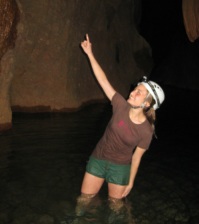Week 6: So this gene walks into a bar and says BLAST meby Natalie Punt Comparative genomics relies heavily on methods to compare genes from one species to another. A popular tool used to compare genes or protein is BLAST. Over the summer, I have been using BLAST to compare cancer-related proteins in the Naked Mole Rat to proteins with similar function and sequence in human, mouse and dog. When I present my work to other students and faculty, I am often met with a resounding, “What is BLAST”? The first time I was asked that question, I thought the student was from a foreign planet, because who hasn’t heard of BLAST?! However, as I was asked the question with increasing frequency I realized that many people have heard of BLAST yet don’t understand how it works. Here, I will attempt to outline the basic concepts of BLAST. In addition, I will give examples of how BLAST has changed our daily lives. Basic Local Alignment Search Tool (BLAST) is accessible at the National Council of Biotechnology Institute, which is through the National Institute of Health. It was released in 1990 with the anticipation of an era of massive whole genome sequencing. The program uses an algorithm to compare a given genetic sequence (protein or nucleotide) to its library of sequences to identify similar sequences. To expedite the process, the sequences are grouped into functional categories such as DNA binding proteins, immune signalers, cell signaling proteins and enzymes responsible for gene expression. I think of BLAST as a little perfectionist driven elf with a PhD in mathematical modeling. When I submit a sequence, he takes it and quickly skim reads it to find short matches between the two sequences and uses this information to identify the sequence as belonging to a specific family. Once he identifies my sequence’s family he pulls out a box containing all of the sequences in that family and begins to compare my sequence to the sequences present in the box. The BLAST algorithm operates on a matrix- which is a simple but complex generalization of differentials. It aligns my sequence with any individual sequence from the box and assigns points for each residue (nucleotide or amino acid) that is similar. Extra points are given for stretches of residues that align. The BLAST elf gets really excited when long stretches from conserved regions align. The elf really likes aligning things as threes, he initially searches for three residues from the conserved family sequences that align. These resides act as the starting point from which he extends the alignment in both directions by groups of threes. As I mentioned early, the BLAST elf is a perfectionist, he wants a perfect alignment and anything that doesn’t align is given a penalty. He faults any group of three residues that doesn’t align. His penalties generate values that indicate the degree of similarity between your sequence and the sequences present in the box. The significance of these scores is evaluated relative to the sequence similarity scores of the other sequences present in the box. BLAST greatly expedites the time to understand what a novel gene or protein does. When BLAST was published in 1990, it was the year’s most cited science paper. BLAST has been used to identify genes in species such as mouse and dog. By taking a dog gene and BLAST-ing it against the human genome-you can identify a gene highly similar between the two species. Comprehensive phylogenetic trees based on a population of species relatedness can be constructed using BLAST for further analysis. Similarly, unknown genes can be assigned a function based on their BLAST hit. Unknown genes can be mapped to their position on a chromosome also based on a BLAST search. Genes or proteins shared between two or more species can be compared to identify conserved domains of that gene family. BLAST is a great tool to use and explaining it is much more difficult than using it. The image of an elf trying to align my sequence with another based on his obsession with multiples of three has helped me visualize the process. About the Blogger
0 Comments
Your comment will be posted after it is approved.
Leave a Reply. |
The Lab JournalWelcome to the summer internship series of 2012! Follow 9 Scientista bloggers through their summer internships to catch a glimpse of what it is like to be a scientista^TM. By Title- India Presents: A "New World Symphony"
- Through The Lens: The Intricacies Of Diabetes - Do Nanoparticles Glow? - Using Unusual Animals to Study Human Disease - Using the Hubble Telescope - You Think What You Eat - Experimenting With the Life of a Scientist(a) - 18.085: My Summer at MIT - Science Heals: A Summer of Global Health Research By BloggerRabeea Ahmed
Riana Balahadia Shaira Bhanji Nzuekoh Nchinda Amy Beth Prager Natalie Punt Juliet Snyder Pin-Wen Wang Stephanie Wang Archives |
The Scientista Foundation, Inc. All Rights Reserved © 2011-2021 | Based in NY | [email protected]
The Network for Pre-Professional Women in Science and Engineering
The Scientista Foundation is a registered 501(c)(3) -- Donate!
The Network for Pre-Professional Women in Science and Engineering
The Scientista Foundation is a registered 501(c)(3) -- Donate!


 RSS Feed
RSS Feed